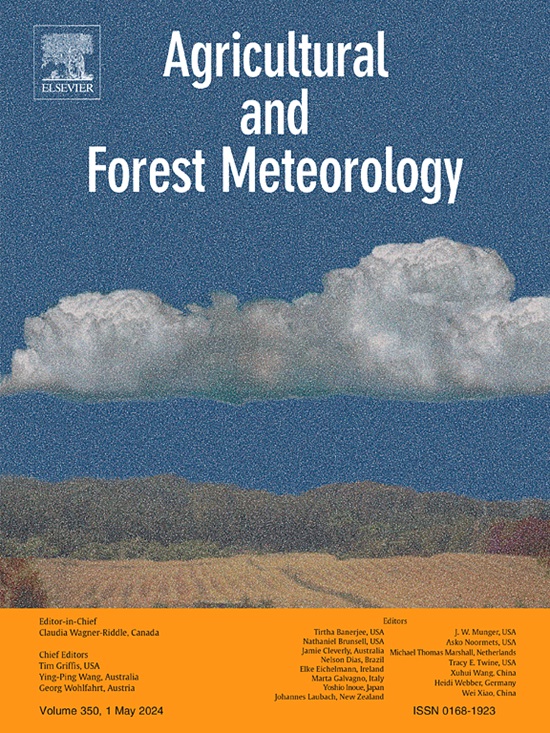绘制全球初级生产总值图的过程模型引导迁移学习框架
IF 5.6
1区 农林科学
Q1 AGRONOMY
引用次数: 0
摘要
准确估算初级生产总值(GPP)对全球碳循环研究至关重要。目前主流的方法,即基于过程的模型,受参数表示不充分和计算成本高的限制,新兴的机器学习方法在应用于GPP估计时仍然存在训练样本不足和可移植性差的问题。因此,本文提出了一种过程模型引导下的全球GPP估计迁移学习方法,以生物圈-大气交换过程模拟器(BEPS)模型的低分辨率(0.5°)估计为源域,以涡动相关(EC)数据为目标域。经过两个域的联合约束,在EC塔数据的基础上,经过缩小比例的预训练和微调,可以获得分辨率为0.05°的相对高精度GPP估计。结果表明,与仅基于EC塔数据(ΔR2 = 0.05, ΔRMSE =−1.02 g C m-2month-1)和原始BEPS估计(ΔR2 = 0.05, ΔRMSE =−14.14 g C m-2month-1)的直接机器学习方法相比,所提出的框架可以显著提高GPP估计的准确性。时间验证和区域交叉验证结果一致,表明该方法具有良好的时空可扩展性。此外,与其他全球GPP产品相比,本文构建的全球GPP新产品可以有效地纠正现有基于机器学习的GPP产品(如FLUXCOM GPP)在高/低GPP区域的低估/高估,特别是在赤道附近区域,并且与基于太阳诱导叶绿素荧光(SIF)和基于模型的GPP产品具有更高的一致性。除了新的全球GPP产品外,本研究的结果也证明了基于过程的模型与机器学习模型相结合在GPP估计中的可靠性。本文章由计算机程序翻译,如有差异,请以英文原文为准。
A process model-guided transfer learning framework for mapping global gross primary production
Accurate estimation of gross primary production (GPP) is critical for global carbon cycle research. The current mainstream approaches, i.e., process-based models, are limited by insufficient parameter representation and high computing costs, and the burgeoning machine learning methods still suffer from inadequate training samples and poor transferability when applied to GPP estimation. Therefore, in this paper, we propose a process model-guided transfer learning approach for global GPP estimation, taking the low-resolution (0.5°) estimates from the Biosphere-atmosphere Exchange Process Simulator (BEPS) model as the source domain and eddy covariance (EC) data as the target domain. After joint constraint from the two domains, relatively high-accuracy GPP estimation at a resolution of 0.05° can be achieved after downscaled pre-training and fine-tuning based on EC tower data. The results indicate that the proposed framework can significantly improve the accuracy of GPP estimation, compared to a direct machine learning method based on only EC tower data (ΔR2 = 0.05, ΔRMSE = −1.02 g C m-2month-1) and the original BEPS estimates (ΔR2 = 0.05, ΔRMSE = −14.14 g C m-2month-1). The results of the temporal validation and regional cross-validation also show consistent results, indicating the superior spatio-temporal expandability of the proposed method. Furthermore, when compared with other global GPP products, the new global GPP product built in this study can effectively correct the underestimation/overestimation in high/low GPP regions in the existing machine learning-based GPP products (e.g., FLUXCOM GPP), especially in the area near the equator, and shows higher consistency with solar-induced chlorophyll fluorescence (SIF)-based and model-based GPP products. In addition to the new global GPP product, the results of this study also prove the reliability of combining a process-based model and a machine learning model in GPP estimation.
求助全文
通过发布文献求助,成功后即可免费获取论文全文。
去求助
来源期刊
CiteScore
10.30
自引率
9.70%
发文量
415
审稿时长
69 days
期刊介绍:
Agricultural and Forest Meteorology is an international journal for the publication of original articles and reviews on the inter-relationship between meteorology, agriculture, forestry, and natural ecosystems. Emphasis is on basic and applied scientific research relevant to practical problems in the field of plant and soil sciences, ecology and biogeochemistry as affected by weather as well as climate variability and change. Theoretical models should be tested against experimental data. Articles must appeal to an international audience. Special issues devoted to single topics are also published.
Typical topics include canopy micrometeorology (e.g. canopy radiation transfer, turbulence near the ground, evapotranspiration, energy balance, fluxes of trace gases), micrometeorological instrumentation (e.g., sensors for trace gases, flux measurement instruments, radiation measurement techniques), aerobiology (e.g. the dispersion of pollen, spores, insects and pesticides), biometeorology (e.g. the effect of weather and climate on plant distribution, crop yield, water-use efficiency, and plant phenology), forest-fire/weather interactions, and feedbacks from vegetation to weather and the climate system.

 求助内容:
求助内容: 应助结果提醒方式:
应助结果提醒方式:


